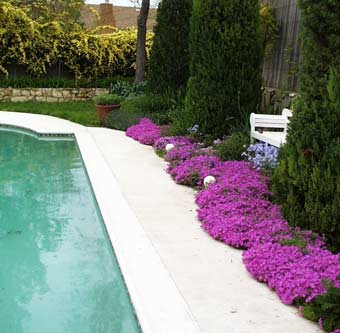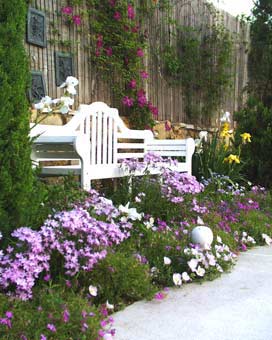French Drain Bed - Spring

|
A French drain runs directly under the pink Phlox subulate (known locally as `pink thrift´). The planting space behind it is of native caliche and lime stone boulders, topped with composted bedding soil. Disdained by some for its raging color, I believe the phlox should be allowed its glory, such as in this 40-foot length. I can understand the criticism when it is arranged `spotty´ in a bed, clashing with softer hues of spring. In this latitude, paler pinks fade in the lens (camera and eyes) from the glare of our intense light, while strong pinks foil the glare. Only in bloom for 4-6 weeks, she serves year-round duty in evergreen edging. Some years, the white iris join her show while the clematis `Ernest Markum´ is opening in a darker shade of brilliance. There was once a 30-foot run of the vicious-thorned `Mermaid´ rose trained along the fence. It is now history and is in the process of being replaced with non-thorny growths.
Phlox subulata is in full bloom in March, followed by the blue Phlox divaricata in April. The taller, more invasive pale pink P. pilosia opens in May. The pilosa needs to be yanked out after bloom, to keep further growth from smothering all else. Leaving a tiny amount of its roots in each clump ensures its next year's return.
One wouldn't expect to see clematis growing in a French drain bed, but they do well in this planting pocket between the retainer wall and swimming pool, because the neighbor's yard sits three feet above ours, bolstered by the wall. The clemmies' roots grow under and behind the wall where it is constantly damp and cool, thanks to downhill seepage. Fortunately their top growth is in the sun which is just what they need: face in the bright sun - feet in the damp deep. Six varieties of clematis grow along the fence line that has become our Clem Utopia. The 'Ernest Markum' variety below, is the earliest to open along with the iris, then others join in soon afterwards.
|
or go to


